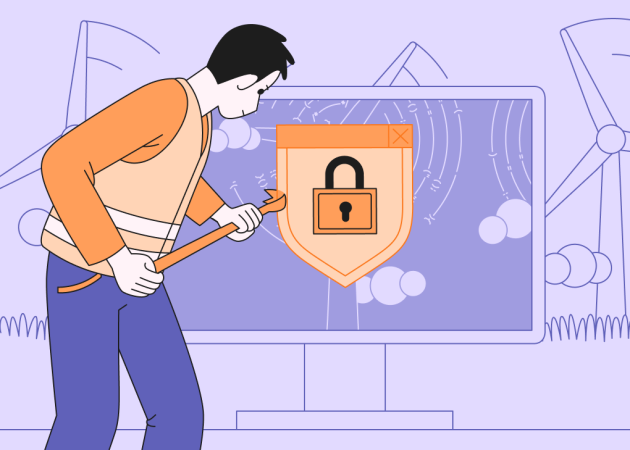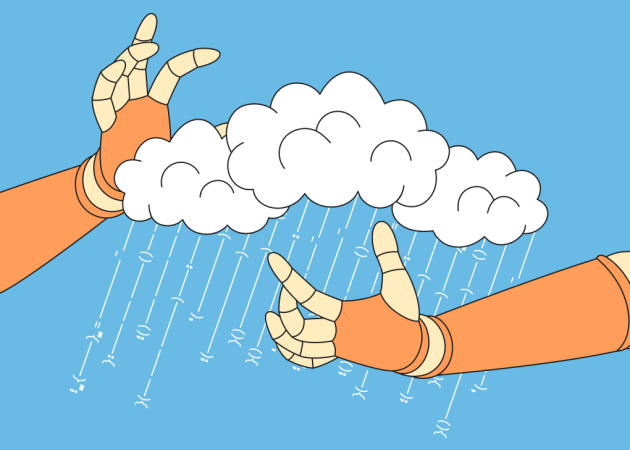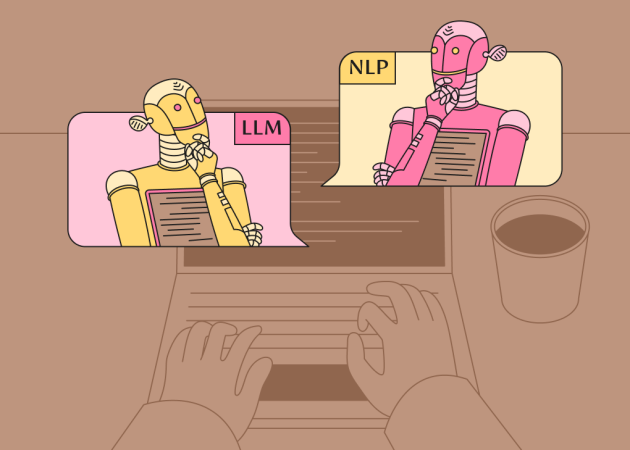
Securing Renewable Data: Green Energy Sector Cybersecurity Challenges
Contents
Contents
Intro
Companies racing to connect new wind farms and battery parks often focus on speed — our overview of in‑demand technologies for renewable‑energy startups shows just how fast the control stack evolves. Yet, the scale can outpace protection. Cyber attacks on critical infrastructure spiked in the last two years.
Renewable energy systems, from wind farms and solar arrays to smart grids, have become prime targets for cyber threats as they digitalize. In 2023 alone, 90% of the world’s largest energy companies suffered a cybersecurity breach. The FBI recently warned that the rapid expansion of renewable power capacity increases the risk of cyber attacks aimed at disrupting generation, stealing intellectual property, or holding critical systems hostage. A successful breach could shut down turbines, knock out solar production, or compromise millions of customer data records.
In short, securing renewable energy data and networks is now as essential as keeping the lights on. Against that backdrop, this article maps the main energy sector cybersecurity challenges, illustrates them with real incidents, and outlines practical counter‑measures — so clean‑power growth remains both green and secure.
Cyber Security Threats in the Energy Sector: Where the Risks Come From
The renewable energy sector faces a perfect storm of risk factors. First, it has become strategically important – electricity from wind, solar, hydro, and other renewables now powers a growing share of homes and industries. This makes it attractive to state-sponsored hackers and criminal groups alike.
Geopolitical Factors
Geopolitical tensions have driven adversary groups linked to Russia and nation-state actors from countries like China, Iran, and North Korea to spy on or probe energy networks. Their motives range from espionage (stealing technical data or plans) to preparing for possible disruptive attacks on critical infrastructure.
On the criminal side, ransomware gangs view energy companies as lucrative targets since knocking out operations puts extreme pressure on victims to pay. Even ideologically motivated hacktivists have tried to compromise energy systems to make a political point.
Distributed Endpoints
Another major risk factor is the vast attack surface created by renewable tech. Unlike a single traditional power plant, renewables are highly distributed – thousands of solar panels, wind turbines, battery systems, and smart meters spread across wide areas.
Industry regulators note the number of susceptible points in electrical networks is growing by about 60 per day as more renewable assets come online. Many of these devices use the Internet of Things (IoT) to communicate, often with minimal security.
Researchers have already uncovered vulnerabilities in solar power systems, raising the concern that hackers could manipulate many at once to cause grid instability or blackouts. Similarly, wind farm control systems and even electric vehicle charging stations now present new points of entry if not properly secured.
IT/OT Convergence
Operational technology (OT) includes the industrial control systems that actually run turbines, manage battery storage, and balance grid load. These systems, often SCADA (Supervisory Control and Data Acquisition) platforms, historically were isolated for safety. However, today’s renewable plants often link OT to corporate IT networks or cloud services for data analysis, maintenance, and efficiency gains.
In short, corporate laptops now link straight into turbine dashboards. Basic IT weaknesses (like exploiting a single phished account) can pivot into operations, as CISA’s advisory on PnPSCADA reminded operators.
Supply-Chain Gaps
Not all renewable energy firms have mature cybersecurity practices yet, especially smaller operators focused on rapid growth. Security by design is not always a priority in the rush to deploy new wind or solar projects. Many companies still struggle with basic “cyber hygiene” – things like keeping software up to date, using strong passwords, and monitoring for intrusions. This can leave easy openings for attackers.
Additionally, GreenTech companies rely on many third-party vendors for equipment and software. When Viasat’s satellite network was compromised during Russia’s full‑scale invasion of Ukraine in 2022, telemetry to 5 800 Enercon turbines across Europe went dark — proof a supplier breach can blind renewable operators.
Ransomware Economics
Criminals know downtime is costly. These dynamics escalate both headline‑grabbing sabotage and the grind of extortionware. Check Point recorded a 70% rise in attacks on U.S. utilities in 2024 compared to the year prior.
The risks come from all directions, and they are growing fast. Little surprise that these dynamics elevate cybersecurity in energy sector discussions from back‑office IT talk to board‑level risk.

Key Cybersecurity Challenges for Renewable Energy Companies
Renewable energy companies face unique cybersecurity challenges that are quite different from those of traditional energy firms. Below is a comparison of how security concerns stack up between conventional energy infrastructure and newer GreenTech systems:
| Aspect | Traditional Energy Security | GreenTech (Renewables) Security |
| Infrastructure & Attack Surface | Centralized facilities (e.g., large power plants) with limited, well-defined entry points. Fewer control systems to protect on-site. | Highly distributed assets (wind turbines, solar panels, etc.) spread over wide areas. Thousands of IoT sensors, inverters, and smart devices expand the attack surface dramatically. |
| Systems Architecture | Often relies on legacy industrial control systems that were historically isolated from the internet. Simpler and segmented networks (air-gapped SCADA networks). | Uses modern networked control systems, cloud APIs, and field apps for remote monitoring and optimization. Older SCADA/ICS now interface with internet-enabled platforms, creating new vulnerabilities. Robust SCADA system security becomes essential. |
| Standards & Regulation | Well-established regulations for critical infrastructure (e.g., utility standards like NERC CIP in North America) enforce baseline security controls, especially for large grid operators. Legacy systems had limited connectivity, which reduced immediate cyber concerns. | Evolving and uneven standards. Utility-scale renewables must meet grid cybersecurity rules, but smaller renewable installations often have no specific cybersecurity standards, and owners put them online for convenience. This gap means many renewable assets may not be held to rigorous security requirements, leading to inconsistent protection. |
| Operational Complexity | Single operators (a utility or plant operator) manage generation. Redundancy and manual fallbacks often exist (operators on-site can override digital controls). | Multi-stakeholder environment: independent power producers, third-party O&M contractors, grid operators, and even “prosumers” (home solar owners) are all connected. Coordination is complex, and a cyber incident can propagate across partners. Many controls are fully remote — a compromise could simultaneously impact numerous sites with little on-site intervention. |
| Threat Profile | High-value target for state actors (e.g., to disrupt national grids) and sophisticated attackers, but smaller criminal groups might be deterred by stronger defenses and lower connectivity. Physical sabotage was historically a bigger concern than hacking. | Mix of ransomware, data extortion, hacktivism, and state actors. Hackers also eye sensitive data (like energy trading info or consumer usage data) from these digital systems. State-sponsored attackers are expanding their focus on renewables to gather intelligence or exploit weaker links in the energy supply chain. In short, GreenTech faces both traditional nation-state threats and a surge in financially motivated attacks. |
As the table suggests, GreenTech firms must contend with a broader and more diffuse challenge. The move toward decentralized, data-driven energy is fundamentally “redefining the attack surface” of the industry. A conventional oil refinery or coal plant could be locked down with fences and on-site guards; a wind farm, by contrast, might have hundreds of remote turbines only reachable via digital networks (and maybe a long drive down a dirt road).
The sector’s digital growth outpaces many companies’ security maturity. SecurityScorecard grades underline the gap: renewable firms average a “B/C+,” while oil & gas peers hold an “A‑.” This means cybersecurity has to cover a lot more ground — literally and figuratively.
Real‑World Incidents and Lessons
Real-world incidents in recent years starkly illustrate the stakes for renewable energy cybersecurity. Each case shows why renewable energy cyber security spending is no longer optional.
Nordex
Perhaps the most vivid case unfolded in April 2022. Conti ransomware hit wind turbine maker Nordex, and the company — active on projects around the world — had little choice but to pull the plug on its IT network and cut remote access to its wind turbines to stop the malware’s spread.
For a time, the company could not remotely monitor or control the turbines it manages, highlighting how a cyber attack can directly impact energy operations.
Vestas
That same spring, a German wind turbine maker, Vestas, was hit by hackers who stole data and threatened to leak it, similarly prompting shutdowns across IT systems. These incidents confirmed that even top-tier renewable manufacturers are not immune.
In fact, Europe’s wind industry was rattled by a series of attacks. Industry reports noted at least three major cyber-attacks on European wind energy companies in a year’s span, including ransomware and supply-chain attacks.
Viasat
The satellite hack mentioned earlier (initially aimed at Ukrainian infrastructure) blinded turbine telemetry in Germany. The collateral damage knocked out remote monitoring for 5,800 wind turbines operated by Enercon, a German wind company.
While the turbines weren’t directly hacked, losing their communications link was like blinding the operators – a vivid example of how intertwined cyber systems can indirectly affect renewable assets.
Iberdrola
It’s not only wind power in the crosshairs. Solar energy systems and utilities have seen breaches, too. In early 2024, Spanish renewable giant Iberdrola suffered a cyberattack that compromised the data of 1.3 million customers, exposing names, contact info, and more. This kind of data breach can undermine customer trust and invite regulatory penalties.
Separately, U.S. authorities have warned that threat actors might target solar farms and microgrids, aiming to alter how solar inverters feed power into the grid. Thus far, attacks on residential solar setups remain rare, but the fear is that as solar installations proliferate, hackers could attempt something more ambitious.
More recent intelligence suggests hostile actors have developed malware frameworks (like the 2022-disclosed Industroyer2 and Pipedream/Incontroller) specifically to disrupt electric utilities’ industrial controls. Green energy installations, if not as rigorously protected, could be softer targets for such tools.
In short, the threat is not hypothetical — renewable energy companies have already been hit by cyberattacks that halted operations and exposed sensitive data. Each incident serves as a wake-up call that “going green” must be paired with “going secure.” The next section looks at how organizations can respond.

Cybersecurity for Renewable Energy: What You Can Do About It
Protecting renewable energy infrastructure requires a multi-layered, proactive approach. GreenTech companies can take concrete steps to mitigate cyber risks and build resilience:
Security-First Culture
Treat cybersecurity as fundamental to operations, not an afterthought. Train your staff to recognize phishing and social engineering attempts (still a common entry point for attackers), employ password policies, and cultivate a culture where reporting anomalies is encouraged and valued. Nail the basics: MFA on every remote login, monthly patch cycles, and relentless phishing drills still block most breaches.
Network Segmentation and Access Control
Separate the operational controls (SCADA/ICS networks) from general corporate IT and external internet access as much as possible. If a malware infection hits an employee’s computer, it shouldn’t be able to spread to your wind farm control system. Use firewalls, demilitarized zones (DMZs), and strict access controls between layers. Implement the principle of zero trust — nothing and no one is trusted by default.
24/7 Monitoring and Incident Response
Given the stakes, renewable energy operators should monitor network activity in real time for anomalies. Unexpected commands sent to an inverter or unusual data flows in a turbine sensor network should trigger alerts. Deploying intrusion detection systems (including specialized OT monitoring tools that understand grid protocols) helps spot attacks early. In parallel, have an incident response plan ready. Keep offline, encrypted backups of critical data and configurations.
Secure‑by‑Design Procurement
GreenTech companies must extend their security diligence to the vendors and partners they rely on. Carefully vet third-party providers — this applies to hardware suppliers, software vendors, and maintenance contractors who might remotely access your systems. Essentially, know your digital supply chain as well as you know your physical supply chain.
Ask suppliers to map their firmware to IEC 62443 or the new UL 2941 inverter standard. Embedding cybersecurity consulting for energy sector clauses — often with partners like Beetroot’s cybersecurity services team — lets experts audit code before it goes live.
Protective Technologies
Use firewalls and antivirus/endpoint protection on all systems, including those running field equipment. Where feasible, enable multi-factor authentication (MFA) for remote access to critical systems. Ensure sensitive data and communications are encrypted, especially any control commands sent over public networks.
Consider deploying modern tools like behavioral analytics and AI to detect subtle intrusions; AI‑driven cyber threat monitoring can flag rogue inverter commands within seconds. Some operators are even using digital twins (virtual models of their grid) to simulate attacks and practice defensive responses.
Regular Audits and Penetration Testing
Don’t wait for attackers to find your weak spots. Perform regular vulnerability assessments and penetration testing of your networks. This includes both IT systems and OT components. Experienced “white-hat” testers can often discover an exposed database or a default password in a turbine controller that an attacker could exploit.
By identifying these in advance, you can fix them (e.g., apply patches, change configurations) before someone malicious does. Many renewable energy companies are now hiring outside experts to assess their SCADA systems and even perform red-team exercises simulating a grid cyberattack. These tests can reveal gaps in incident response and help train your team under pressure.
Collaboration and Information Sharing
Cyber threats evolve quickly, and no company is an island. GreenTech firms should actively participate in industry information-sharing groups (like the Electricity Information Sharing and Analysis Center — E-ISAC — in North America or energy CERTs in other regions). Sharing indicators of compromise and threat intelligence can help the entire sector respond faster.
The renewable energy community is tight-knit in advancing CleanTech — that same spirit is needed to collectively defend against cyber adversaries. When one company learns a hard lesson from an incident, others should take note and improve their safeguards accordingly.
For an eco‑angle, our piece on green cybersecurity and sustainable data protection explores low‑energy encryption strategies that align with decarbonization goals.

Conclusion
The transition to renewable energy transforms not only our power sources but our digital infrastructure as well. As clean energy technologies accelerate and connect to every part of the grid, they bring immense benefits in efficiency and sustainability but also new vulnerabilities to manage.
The good news is that the industry is waking up to these challenges. From wind farm operators hiring cybersecurity chiefs to solar inverter manufacturers strengthening their device protections, efforts are underway to close the gaps. Governments and regulators, too, are enacting stricter rules and facilitating collaboration to bolster defenses.
Still, the onus lies on each organization in the renewable ecosystem to assess its own risks and take action. As we’ve discussed, practical steps — from network segmentation and patch management to employee training and incident drills — can drastically improve a company’s security posture. Cyber attacks may still occur, as they will in any industry, but with strong defenses, most can be thwarted or contained before they cause major harm.
Beetroot helps companies across many industries strengthen their cyber protection through tailored expertise — whether it’s about strategic team extension, cybersecurity consulting for the energy sector, or hands-on specialized team training. We will be glad to offer a solution that meets your business needs. Contact us today to see how we can help.
FAQs
Why is renewable energy vulnerable to cyber attacks?
Renewable energy systems are highly digital and connected, which makes them attractive targets. The rapid expansion of renewables creates more points hackers can try to exploit. Unlike older isolated power plants, modern renewables use networked control systems, IoT sensors, and cloud platforms.
This broad attack surface means determined attackers (from cybercriminal gangs to nation-state hackers) have many avenues to attempt intrusions. Additionally, some renewable energy operators are newer companies that are still building their cyber defenses, which can make them relatively softer targets.
How do smart grids increase cybersecurity risk?
In a traditional grid, power flowed one way from a central plant outward. In a smart grid, many distributed assets (rooftop solar, smart appliances, electric vehicles, etc.) communicate with utilities and even autonomously adjust demand or supply. This interconnected web means a hacker could target not just a central control room but potentially any node in the network — a compromised smart meter or EV charger might be a jumping-off point, making cybersecurity for smart grids a specialized discipline.
Moreover, smart grids rely heavily on sensor data. In short, smart grids introduce complexity and dependency on digital control, which must be managed with robust cybersecurity (encryption, authentication, anomaly detection) to prevent bad actors from exploiting the very intelligence of the grid.
What is the role of SCADA in energy cybersecurity?
SCADA (Supervisory Control and Data Acquisition) systems are the digital brains that monitor and control industrial processes in the energy sector. In a wind farm or solar plant, for instance, the SCADA system lets operators remotely see performance data and send commands (like adjusting a turbine’s settings or opening a circuit breaker). Because SCADA directly interfaces with physical equipment, it’s absolutely critical to operations and a high-value target for attackers. If hackers breach a SCADA system, they can potentially manipulate equipment (shut down turbines, cause overloads, etc.) or hide real-time data readings. Any weakness in SCADA security can be an open door to disrupting the flow of power, which is why robust SCADA system security is critical.
What are common cyber threats to renewable energy companies?
Renewable energy companies face many of the same cyber threats as other industries, with a few that are particularly impactful for critical infrastructure. Some of the most common threats include:
Ransomware: Attackers infiltrate the network and encrypt critical data or control systems, then demand payment. Ransomware can halt operations (turbines offline, etc.) until systems are restored, causing major losses.
Phishing and Social Engineering: Energy staff are targeted with convincing fake emails or messages to steal their passwords or trick them into executing malware. A successful phishing attack can give attackers a foothold in the company’s IT network, from which they may move into OT systems.
Malware and Zero-Day Exploits: General malware (trojans, worms) or specific exploits against unpatched software. For instance, if a solar farm’s SCADA software isn’t updated, a known vulnerability could let an attacker crash it or take control. Some malware is tailored to industrial systems (like the infamous Stuxnet), and energy infrastructure could be a target for such specialized threats.
DDoS Attacks: Hackers may flood the company’s internet-facing services (like customer portals or even grid communication links) with traffic to overload them. A well-timed Distributed Denial of Service (DDoS) attack could disrupt a renewable energy company’s ability to coordinate resources or communicate, albeit usually temporarily.
Insider or Supply Chain Threats: An unhappy insider with access to control systems could misuse credentials, or a compromised software update from a vendor could introduce a backdoor. These are harder to defend against but are known issues (for example, attackers may try to bribe or coerce insiders at utilities or slip malicious code into widely used inverter firmware).
State-Sponsored Intrusions: Though less common than criminal attacks, state-backed groups might infiltrate a renewable energy network to gather intelligence or position themselves to cause damage in a conflict. Such attackers might quietly map out the network and go undetected for long periods.
Subscribe to blog updates
Get the best new articles in your inbox. Get the lastest content first.
Recent articles from our magazine
Contact Us
Find out how we can help extend your tech team for sustainable growth.







